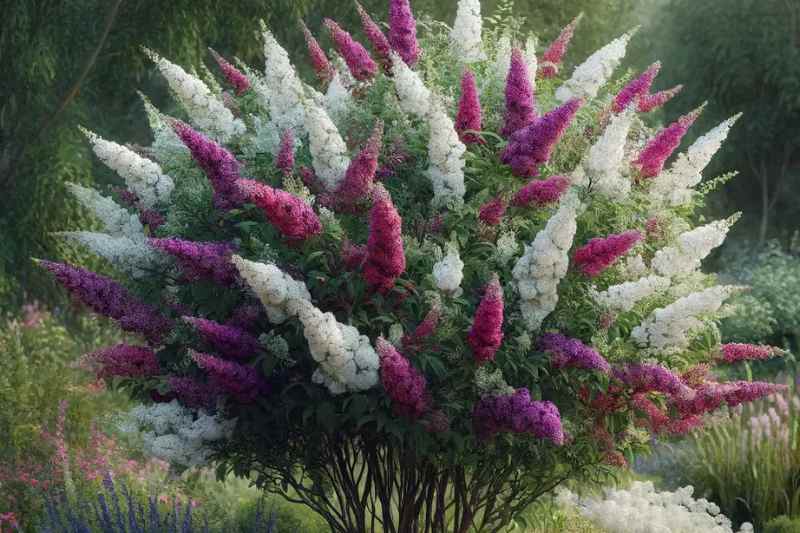Oh, look at this: a buddleia or Butterfly Bush that produces three types of flower colours! It's amazing! It's unbelievable! It's... strange, isn't it? How could such a marvel occur? A genetic aberration? A risky grafting? Or are they just pulling our leg a bit? The editorial team at Promesse de Fleurs has investigated.
The Buddleia Tricolor on paper
On paper or in online photos, this Buddleia davidii is indeed tricolour, proudly displaying (well, we can't really ask the bush) the three colours: blue, pink, and white. All in a too perfectly symmetrical arrangement (still on paper!) to be honest.
It's ugly, you might say? Well, that's subjective. But you must agree that this bush doesn't have an easy look. Let's just say it's special... Yet, it's one of the best-selling shrubs at the moment. Go figure!

But what about in reality?
In reality, hold on to your spade, this Buddleia does not exist! At least, what you see in the doctored photos from catalogues does not exist. The Buddleia Tricolor is merely the commercial name of a "product" made up of three varieties of Buddleia: generally Buddleia 'Empire Blue', Buddleia 'Pink Delight', and Buddleia 'White Profusion'. These three fellows growing in the same pot. (please note: the varieties may actually differ depending on the market... a bit like Isio 4 oil).
Yes, but there's a "catch". The first year of planting, everything goes relatively well, but over time, one of the three shrubs, too tightly packed, will take over the other two and you'll soon find yourself with just one variety of butterfly bush. That's unfortunate! Especially at the price we pay for this Frankenstein monster.
So? Scam or not?
Yes and no. The issue does not stem from selling a pot with three different varieties. This is quite common. I’m thinking particularly of the 'Three Sisters' series: Rhododendron, Lilac, or Camellia... Yes, yes, we sell these weird things too. We’re not particularly proud of it, but they sell. It’s "trendy".
The problem lies more in the fact that horticultural professionals do not communicate clearly with the customer. 95% of gardeners do not know what these multicoloured varieties actually are, with most retailers remaining very vague, even evasive on the subject. Adding to this, they provide a poorly photoshopped illustration that bears absolutely no relation to the reality of what you will receive and attempt to grow.
Moreover, they make us believe — and it’s written in black and white on their sheets — that it’s a new variety. However, this is entirely false: placing three plants in the same pot is not enough to qualify it as a "variety". Furthermore, the commercial name should not be placed in single quotes, as is commonly seen: we do not mess around with botanical nomenclature!
So here, yes (and even a big YES), it’s deception, it’s stamping, as they clearly take the customer-gardener for a big pigeon, to put it politely...
In short, if you see this type of shrub in a catalogue, look the other way! When it seems too good to be true, in the world of horticulture or elsewhere, there’s usually something fishy going on...































Comments